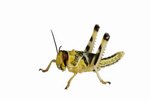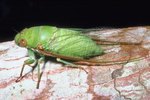
People generally consider insects as a nuisance, and many are even afraid of them. Though there are millions of different types of insects, not all are scary -- but many of them are indeed pests. Of these, burrowing insects can present large problems to people and the areas they inhabit.
Emerald Ash Borer
Also known as Agrilus Planipennis, the emerald ash borer originates in Asia, but causes destruction to ash trees worldwide. Since their discovery in 2002, these insects have killed millions of trees in the United States. Larvae bore into the bark of trees for several weeks, growing to over an inch in size before pupating and emerging in the spring as metallic dark green adults that are about 1/2-inch long. These beetles prefer to lay eggs on dying trees, but infestations may occur in healthy trees as small as 1 inch in diameter. Most infested trees die within 2 years.
Mining Bees
Mining bees, which are also called "burrowing bees" and "digger bees," are a non-aggressive species that nest in solitary, underground locations. Though nests typically only house one "family" of bees, sites with many nests are common in well drained soil near roadways, hills and riverbanks. Although not prone to stinging, these bees can make their nesting ground unstable and cause unease due to large populations. Food for mining bees includes flowers and nectar, which is stored within the nest as reserves. Covered with fine yellow or brown hair, their bodies resemble that of honey bees in both size and shape.
Termites
Both the dampwood and drywood varieties of termites present potential problems to wooden structures and trees. Not only do they burrow through wood items, but they also destroy paper, insulation and even pool filtration systems. The winged termites are "swarmers" that leave the initial nest to begin new colonies each spring. Swarmers cannot begin new colonies indoors, but are a good way to detect an infestation. After finding a new location, they shed their wings and mate. Though they destroy wood, termites live in the ground and build transportation tubes to move safely between the structure and their home. Termites range in size from 1/2-inch to 5/8-inch long, and may be milky white, brown or black in color.
Cicadas
A cicada's destructive habits begin at birth, with newborns falling from trees and burrowing into the ground. There, they latch onto tree roots, feeding on water and nutrients that help them grow for between 2 and 17 years. When they emerge, they re-climb trees, shed their exoskeletons and begin the mating process. Females dig grooves into tree branches to lay eggs, which can eventually kill branches. Adult cicadas, especially the periodical cicadas, are known for their large black bodies, bright orange eyes and yellow-tinged wings. Adult cicadas can reach sizes of over 2 inches, making them much larger than the average insect.
References
- Ohio Department of Agriculture: Emerald Ash borer
- Emerald Ash borer: Frequently Asked Questions
- Washington State University: Mining Bees
- University of Rhode Island Greenshare: Termites
- Pest World: Termites
- Cicada Mania: What are Cicadas?
- University of Kentucky Department of Agriculture: Termite Control: Answers for Homeowners
Photo Credits
-
China Photos/Getty Images News/Getty Images




